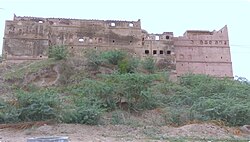Kumher (formerly Kumbher) is a historical town and land of Yaduvanshi Sinsinwars the initial name of this town was Kuber. It is located in Deeg District of Rajasthan, India.
Kumher
Kumbher | |
|---|---|
Town | |
 Kumher Fort in 2017 | |
| Coordinates: 27°19′N 77°22′E / 27.32°N 77.37°E | |
| Country | |
| State | Rajasthan |
| District | Deeg |
| Elevation | 176 m (577 ft) |
| Population (2001) | |
• Total | 20,294 |
| Languages | |
| • Official | Hindi |
| Time zone | UTC+5:30 (IST) |
Geography
editKumher is located at 27°19′N 77°22′E / 27.32°N 77.37°E.[1] It has an average elevation of 176 metres (577 feet). Kumher is also the birthplace of the illustrious Arya Samaji Vedic and Ayurvedic scholar, Pt. Satyendranath Vaidya (1902–1982).
History
editKumher was founded by a Jat chieftain Kumbh in 1704. In 1754, when Maharaja Surajmal of Bharatpur was the king, the fort at Kumher was sieged by the Marathas as Peshwa Balaji Baji Rao's younger brother Raghoba (supported by chieftains Scindias and Holkars) wanted Surajmal to be subservant to them. However, the siege did not succeed. In 1754, on behest of Mughal Emperor Alamgir II, Khanderao laid the seize of Kumher fort of Jat Maharaja Suraj Mal of Bharatpur State who had sided with Alamgir's adversary Siraj ud-Daulah. Khanderao Holkar, son of Malhar Rao Holkar, was inspecting his troops on an open palanquin in the battle of Kumher when was hit and killed by a cannonball from the Jat army. Marathas (particularly Scindias and Holkars) signed a treaty with Surajmal and withdrew their army. To honor Khanderao, Suraj Mal built a Chhatri on the cremation spot of Khanderao at Kumher.[2][3][4][5]
Demographics
editAt the time of the 2001 India census,[6] Kumher had a population of 20,294. Males constitute 54% of the population and females 46%. Kumher has an average literacy rate of 54%, lower than the national average of 59.5%. Male literacy is 65%, and female literacy is 40%. In Kumher, 19% of the population is under 6 years of age. Famous Kishori Mahals (Palaces), Jal Mahal's are in Kumher. Kumher is also part of Braj Bhumi includes Govardhan Parikrima and Punchri Ka Lotha. Famous Temples in Kumer are Satya Narain Mandir, Hanuman Mandir, Jaharbir Baba Mandir, Guru Gorakh Nath Mandir, Shaktidhaam Mandir, Man Santoshi Mandir, Man Jwala Devi Mandir, Shri Ganeshji Mandir, Luxminarain Mandir, Tapsi wale Hanuman Mandir.
References
edit- ^ Falling Rain Genomics, Inc - Kumher
- ^ Advanced Study in the History of Modern India 1707-1813, by Jaswant Lal Mehta, pp606
- ^ Images of Women in Maharashtrian Literature and Religion, edited by Anne Feldhaus, pp185-186
- ^ Omkareshwar and Maheshwar: Travel Guide, p60
- ^ Indian States: A Biographical, Historical, and Administrative Survey, by R. V. Solomon, J. W. Bond, p.72
- ^ "Census of India 2001: Data from the 2001 Census, including cities, villages and towns (Provisional)". Census Commission of India. Archived from the original on 16 June 2004. Retrieved 1 November 2008.

